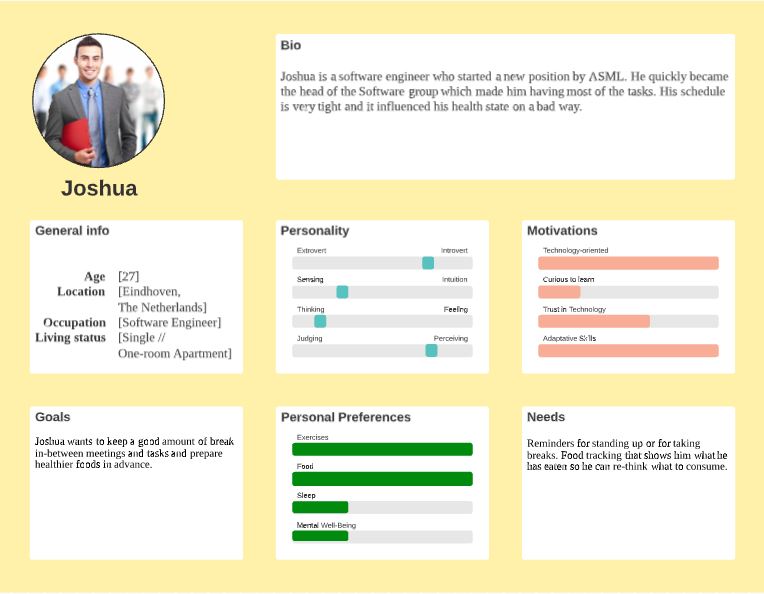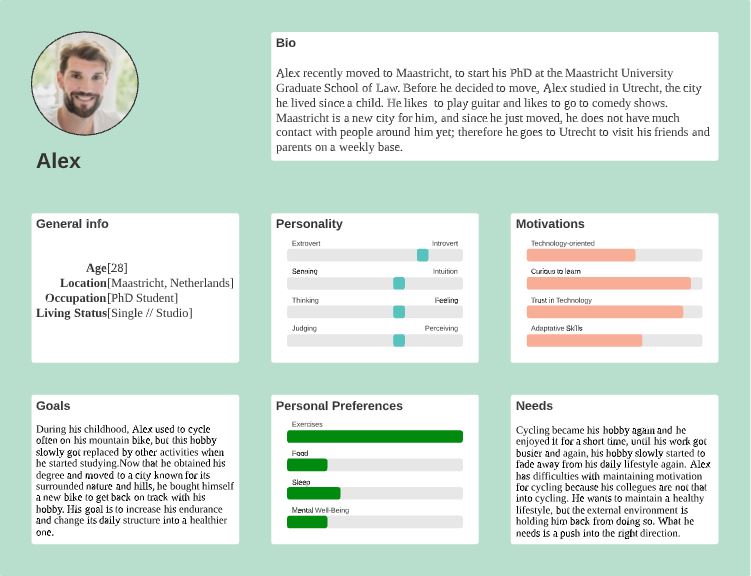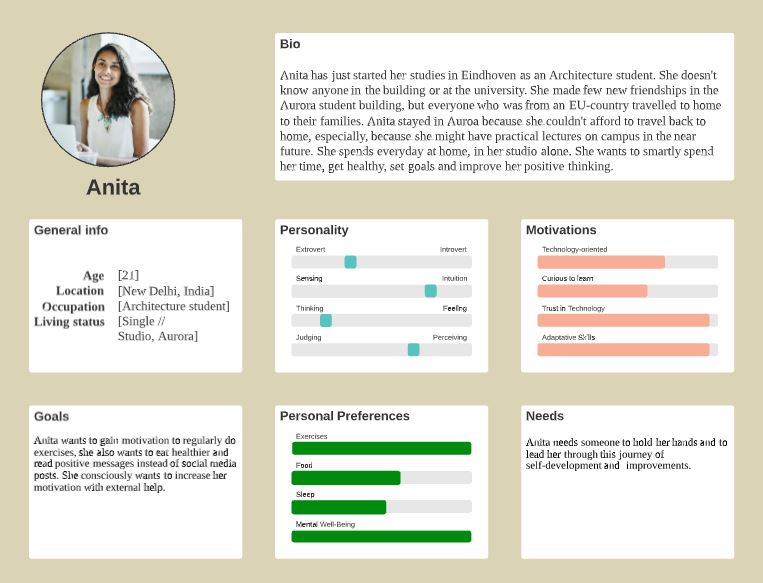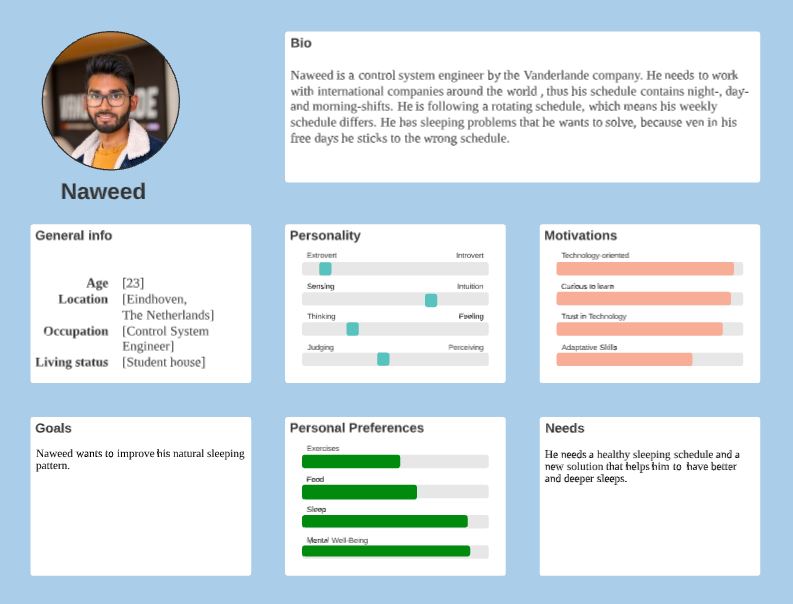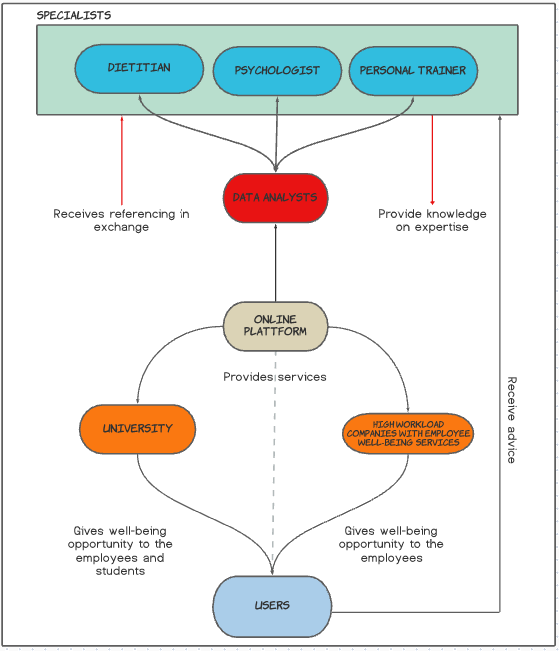PRE2020 3 Group8
Group description
Abstract
A pure software end-user application that supports people in their need to socialize while motivating self-improvement. Anthropomorphism is intentionally used to increase user commitment and experience. Machine learning techniques are used to process user's data and provide feedback, and to facilitate the anthropomorphized interface.
Conceptualized Idea
Hypothetical idea: A webpage/application, that will motivate its users into a more (mentally) healthy way of living life. The user can put in any preferences to be motivated on and set its own goals. Numeric data of the user will be tracked in a communicative way rather than filling in forms, is stored and compared to older data, and reflection of this comparison will be given in a personalized way back to the user.
On this page, the concept of this motivating coaching system will be presented. This system combines specialized monitored and self-measured data from its user with individual and reference knowledge to give its users an overview (and recommendations). The system will keep track of one’s daily life structure, translate and summarize the numerical input into recommendations in a continuous personalized motivating coaching dialogue taking into account the needs and preferences of each user individually.
Members
| Name | Student number | Department |
|---|---|---|
| Edwin Steenkamer | 1006712 | Computer Science |
| Emi Kuijpers | 1227154 | Psychology & Technology |
| Fanni Egresits | 1316400 | Psychology & technology |
| Morris Boers | 1253107 | Computer Science |
| Lulof Pirée | 1363638 | Computer Science |
Main Task division
| Task | Members |
|---|---|
| Machine Learning | Lulof & Edwin |
| User Interface | Morris |
| USE-part | Fanni & Emi |
GitHub Page:
Logbook
See the page logbook_group_8
Problem statement and objectives
Problem Statement
Often loneliness is associated with elderly people living unintentionally in social isolation due to unfortunate circumstances. However, the reality is that loneliness is experienced by all ages and almost all humans. [1] Humans are social animals [2], and we humans influence each other by merely existing together. Loneliness is seen as a severe public health issue due to its association to increased risk of morbidity and mortality [3]. A study by Luhmann & Hawkley [4] suggests that the prevalence rates of loneliness are highest for young adults (<30 years).
Loneliness can best be stated as the perceived discrepancy between the desired amount and the actual perceived amount and quality of social communication and relationships. [5] Both physical, as well as mental health and overall well-being, can suffer from this. With less social relationships, less comparison and facilitation from others will influence a person's behaviour and motivation, leading to a decrease in intrinsic motivation.
Due to the COVID-19 pandemic restrictions, many people are forced to stay at home [6]. These restrictions also cause personal trainers, dieticians, and other employees that help people engage in a more healthy lifestyle to be unable to work with the normal citizen. However, at this very moment, people must maintain a healthy lifestyle. Exercising and healthy lifestyles increase at the beginning of covid. After the restrictions aimed at minimizing the risk of local transmission of SARS-CoV-2 got stricter, it is more likely that this leads to reductions in physical activity. [7] Therefore, it is necessary to find other ways to externally motivate people to maintain a healthy lifestyle independent of other people's motivation.
Besides the external motivation that humans get from other people, we also can motivate ourselves. People have a very complex decision-making process, and not always the rationally right decision is chosen for a particular event or action. Heuristics are used as a mental shortcut to make decisions and are simplifications. These can occasionally lead to systematic flaws and errors, which are deviations from the normative decision-making model, known as biases.
One of these biases is overconfidence, a bias during interpreting and assessing information, the second step in the decision-making process. People are often biased in their confidence concerning the hypothesis they have brought in their working memory, believing that they are more correct more often than they actually are. For example, if people would have to report how much they ran during a jog, they will most likely unconsciously overestimate themselves. [8] There is also the psychological phenomenon called planning fallacy, where people underestimate the time it will take to complete a future task. [9] Combining this will optimism bias, which explains our tendency to overestimate the likelihood of experiencing positive events and underestimate the occurrence of negative events. The human mind can sometimes be a dangerous decision-making toolbox to rely on. Using this system, the data gathered from the user will serve as a toolbox. They can be seen as an extended memory that provides the user with statistically true information so decisions will be made taking into account actual statistics, rather than only the estimations and thoughts humans have left of past events. In this way, users will be calibrated towards the truth and rely less on decisions made while possibly be biased.
Needs
Two needs arise from the problem statement above. Firstly, to reduce biases in the decision-making process due to falsely remembered memories, people need to be provided with an objective summary of their past events. Secondly, the net amount (both intensity and frequency) of negative emotions and lack of motivation experienced due to a lack of social interaction must be decreased to fill the lack of external motivation. A system is needed that enhances intrinsic motivation and also provides personalized social interaction to the user to enhance engagement while using the system.
Goals
To reach the needs stated above, the software application has two main requirements:
- Firstly, the system's main aim is to provide users with insight in parts of their behavioural patterns that are unknown to them. Humans tend to rely heavily on their intuitions, which can often strongly deviate from its true value. The system will serve as a non-biased evaluation tool, which will result in the user discovering behavioural patterns after a fixed period based on their objective data, rather than intuitions and memory.
- Secondly, to increase the motivation of the user to put in data, and to enhance positive changes in behavioural patterns, anthropomorphic features will be used while designing the system. Using a human-like question generator to let the user put in data rather than a non-interactive (for example, a questionnaire), the user will perceive a need to answer the system rather than merely filling in the data. The aim here is to increase motivation and overall well-being by presenting the data's reflection in a personalized way.
Beyond the scope
The following features are probably valuable additions to the product, but they are beyond the scope of what can be achieved in one quartile:
- Voice recognition, natural language text inputs (natural language processing is too much to add within the given timespan)
- Animated anthropomorphized interface (e.g. simulated face)
Current State-of-the-art
Social Agent Coaches
Exercise
Bickmore and Picard developed a computer-based virtual relational agent that served as a daily exercise advisor by engaging the user in conversation and providing educational information about walking for exercise, asking about the user's daily activity levels, tracking user progress over time while giving feedback, and engaging the user in relational dialog. [10] These kind of social agents are also used often as a weight-loss advisor coach. [11]
Food
TODO
Mental Health
TODO
Sleep
TODO
In the system, the agent is both an administrator and active participant in the health-related activity, resulting in a unique characteristic for the system: The social interaction between the robot and the user is not only useful for maintaining user engagement and influencing intrinsic motivation but is also an instrumental necessity in achieving the healthy behaviour.
Competitor Analysis
- Still in progress
In conclusion, most AI assistants are used for marketing strategies or for analytical tasks. The complexity of the health and well-being related software is very low. The AI Assistants are mainly used for asking repetitive questions in the form of daily reports and to do generic measurements with Smart bracelets or watches. Compared to these devices, we concluded that our AI would bring new functionalities to the market. In reflection to other AI assistants, _NAME_ uses its personalized questionnaire during the set-up of the software and based on that analysis the performance of the user, gives feedback and guidance with subjective questions during the day. Our team targeted four perspectives and decided to focus on well-being, healthy eating, sports activity and sleeping.
The main functionality that made our product outstanding is the use of the self-reflection technique on the users. After doing market research and conducting questionnaires, we realized the main goal is the increase of motivation. In order to accomplish this, the users reflect on their own performance and answer their own questions such as why they make specific decisions, how their decisions influence them and how they can use their knowledge for their own benefit. During the market research, one of the obvious realizations was that people lose interest just by seeing notifications or comparisons to other users.
Therefore, our product would rely on incorporating strategies from cognitive-behavioural therapy, accepting and committing therapy, mindfulness, and other science-based approaches. This could be the key element to increase intrinsic motivation. The Youper (https://play.google.com/store/apps/details?id=br.com.youper&hl=en_IN) named software stands the closest to our idea, but it focuses on the stress and mindfulness perspectives.
Compared to Youper we would add sport performance measurements and diet helps. As seen in the stakeholder analysis, we would involve additional specialists in the project which would give more opportunities and better reliability. Additionally, Wysa, the interactive penguin assistant provides similar services [12]. The penguin assistant has a highly developed AI system for any kind of mental therapy, although the software deals only with mental well-being. With _NAME_ we tried to combine all the options together and create something that deals with not only mental well-being but also with the physical state.
DESIGN
While designing the system that will enhance healthy behaviour in a pro-active way, we followed the design methodology, which asserts that the SAR agent must possess [13]:
(1) The system must have the ability to influence the user's intrinsic motivation to perform the task.
(2) The system must have the ability to personalize social interaction to maintain user engagement in the task and build trust in the task-based human-robot relationship.
Only with these characteristics can the system be implemented successfully and be effective in one's life. The two characteristics will be explained below.
Influence the user's intrinsic motivation
First, the system must have the ability to influence the user's intrinsic motivation. Intrinsic motivation comes from a person itself, and it has been shown that intrinsic motivation is more effective for long-term task compliance and actual behaviour change. [14]. Intrinsic motivation does not have to be triggered by the person itself, but can also be affected by external factors, for instance, by a (digital) instructor or coach. Through positive and negative (verbal) feedback, the intrinsic motivation of the user can be affected.
Below, three characteristics of a system that influence intrinsic motivation according to previous studies have been explained briefly, which will later be implemented in our system.
Competition
Humans like to compete against each other and improve themselves, and be challenged to compete against an ideal outcome. Studies show that humans perform better in a competitive environment compared to a non-competitive environment. [15] [16]
Therefore, it is important to consider designing and providing weekly summaries, high scores and comparisons to the user. These concepts tend to increase the intrinsic motivation for the task [17]. The user must be exposed continuously to their performances for motivational purposes. % our system does this by ………..
Reward and Criticism
Both reward and criticism are two forms of feedback a digital coach can give. According to a study conducted by Vallerand and Reid (1984), forms of negative feedback – criticism and punishment – is considered to have a negative impact on the intrinsic motivation of the user [18]. On the other hand, Vallerand also stated in another study (1983) that positive feedback – praise and reward – tend to positively impact the user's intrinsic motivation [19].
However, it is essential to note that the effect of positive feedback is closely tied to the user's own perceived competence at the task. Once a user believes he is doing an excellent job while performing a task, praise and reward are no longer affecting intrinsic motivation.
It is decided that the system will not provide any negative feedback and only praise and reward the user upon correct completion of tasks and when following up the right advice. With this, the user can be helped with getting a healthier lifestyle without a decrease in intrinsic motivation.
Autonomy and Self-determination
To achieve long-term behaviour change, the system should support user autonomy and self-determination [20] Users do not want unnecessary information and do not want to put in data that they think is unnecessary.
Therefore, the user will have the freedom to choose the preferences he/she wants to be advised for. The users can also set the amount and timing of notifications and can also put in questions themselves. User choice and the level of autonomy a user wants differs per system and innovation. This makes self-determination a fascinating concept that must be studied specifically for this system with a user-study.
Personalized Social Interaction to maintain User Engagement
TODO '
Anthropormorphism The tendency to attribute human features or behaviour to non-human agents is called Anthropomorphism [21]. With human features, emotions are also included. Humans are fundamentally emotional beings, which causes that human communication and social interaction is not purely based on rationalities, but also include emotive or affective variables. Therefore, to truly motivate the end-user to long-term behaviour change, emotional responses must be evoked by the user.
Anthropomorphic design principles are often employed to facilitate interaction and acceptance. In social robotics, this is often done by designing a physical embodiment with human-like features [22]. To make the system easily accessible and feasible for most people of the target group, it has been chosen to design a system for % !!!!! (website/app/???) devices.
Conclusion
User description
Primary Target Audience The application will be designed to be used by technology-oriented adults (mainly focusing on minus 30 years), who interact with computers and smartphones on a daily basis. The main target for this system are students who spend most of their time alone in their student accommodation. This can both be due to contemporary COVID-19 pandemic stay-at-home regulations, but also for users who live abroad for a short time, for example.
The focus will also be on people who want to improve their daily structure and overall well-being in any way but have no idea what would be best for them. Therefore, the system will provide its user with objective data to discover clear behavioural patterns that might have lead to certain events. Users are more extensively described at the user analysis-section. %refer to user analysis on the wiki. If wiki still unavailable, delete sentence. The application will likely not be suitable for children due to its design constraints, or for elderly people who are not technology-oriented and adapted to new technologies.
User requirements
To engage positive behaviour in people using an AI application, an accessible and practical user-interface is critical. An irresponsive, unintuitive or unfinished interface may discourage users from using the application, let alone be positively nudged by the application. Users need to perceive social engagement and be positively motivated by the system to change its behaviour.
User Analysis
Persona Storyboards
Approach, milestones and deliverables
Milestones
The project milestones are divided into three main parts: Implementing a human-centered design approach, the system's economical value and the software milestones.
User-centered Design
Target User-perspective: Human-Centered design
- Perform user analysis
- Describe the potential main users and their needs
- Provide several persona scenario's.
- Define boundaries for user requirements
- Research needs to be conducted on how different system features will motivate its users and trigger them to change their behaviour in a non-intrusive, engaging way.
- Secondary end-users and stakeholders (developers, the scientific community) need to be defined and described.
Potential Ethical Threats
- Negative anthropomorphism: By adding human-like features to non-human agents, it is essential to consider possible threats of cognitive deception. The user must be (and stay) aware that the responses are computationally generated.
- Paternalism: The system is designed to provide its user's insight into their behaviour and motivate them objectively to make positive changes. Hence, the system is deliberately nudging the user. A sufficient amount of care must be taken not to exploit this capability to act against the user's interest.
- Intruding one's privacy: Research has to be investigated to find an optimum amount of tradeoff between the user trusting the system enough to give a sufficient amount of data without negatively intruding the user.
Comparative advantage, product innovation and improving Quality of life of its users
- Essence and uniqueness of the project need to be defined.
- Describe current state-of-the-art, combining it with essence and uniqueness to state comparative advantages.
- Define the actual perceived gain of the end-user.
Economical perspective
Economical value
In this section, the preferences of the given users are described that determine the economical value of our product. This can be defined by a survey/questionnaire or by market-research.The economical value of the product is the benefit that the costumers receive from the usage of the AI software. In the case of the specific device we develop, this could be the motivation, joy, health,fun..etc. This value is not an objective characteristic, but rather subjective, since it differs by its user's needs and expectations. Because of this diversity, our proposal is a survey conduction before the start of the program to collect enough information for a fully personalized service. On this way, the economical value to the customers (EVC) can be determined and the market price of the software can be quantified. \\ After the market-research, we plan to create a competitor-analysis which helps us to see which additional tools we need to implement and what the essence and uniqueness our product could be compare to our competitors. This step will also help us to narrow or extend the list of stakeholders we want to approach. This information will enable us to create a value network,a cash-flow for the upcoming semester and to develop a business plan.
Stakeholder analysis
A stakeholder analysis of an issue consists of finding the equilibrium of different demands from different perspectives. The stakeholder map shows which stakeholders will be considered, moreover, it will help to identify the interests and mechanisms of the stakeholders to influence other stakeholders, key people, competitors and to reduce potential risk. The center is the online platform in the center which connects every stakeholder and provides access to the AI assistant. The main target group is the users, described above. With the marketing, the first targeting would reach the bigger associations, companies or universities, furthermore individuals who personally are interested. The idea is to include specialists, such as dietitians, psychologists and personal trainers. The data analysts are mainly members in our current team who could work in collaboration with the specialist as an exchange in knowledge and expertise. Our team would provide referencing to the specialists by our customers in case the users wish to use the help of physical specialists, e.g. receive a proper diet plan from a dietitian, set a bigger goal for weight loss with a personal trainer or get better help from a psychologist. The help of the specialists could be included in the watch.
The collaboration with bigger companies e.g. IT companies where the employees are required to work long with a busy schedule or to do night-shifts would give an opportunity to help to maintain health goals for the employees. Universities could also profit from the services and help the well-being of their students and employees.
Competitor analysis
- Still in progress
In conclusion, most AI assistants are used for marketing strategies or for analytical tasks. The complexity of the health and well-being related software is very low. The AI Assistants are mainly used for asking repetitive questions in the form of daily reports and to do generic measurements with Smart bracelets or watches. Compared to these devices, we concluded that our AI would bring new functionalities to the market. In reflection to other AI assistants, _NAME_ uses its personalized questionnaire during the set-up of the software and based on that analysis the performance of the user, gives feedback and guidance with subjective questions during the day. Our team targeted four perspectives and decided to focus on well-being, healthy eating, sports activity and sleeping.
The main functionality that made our product outstanding is the use of the self-reflection technique on the users. After doing market research and conducting questionnaires, we realized the main goal is the increase of motivation. In order to accomplish this, the users reflect on their own performance and answer their own questions such as why they make specific decisions, how their decisions influence them and how they can use their knowledge for their own benefit. During the market research, one of the obvious realizations was that people lose interest just by seeing notifications or comparisons to other users.
Therefore, our product would rely on incorporating strategies from cognitive-behavioural therapy, accepting and committing therapy, mindfulness, and other science-based approaches. This could be the key element to increase intrinsic motivation. The Youper (https://play.google.com/store/apps/details?id=br.com.youper&hl=en_IN) named software stands the closest to our idea, but it focuses on the stress and mindfulness perspectives.
Compared to Youper we would add sport performance measurements and diet helps. As seen in the stakeholder analysis, we would involve additional specialists in the project which would give more opportunities and better reliability. Additionally, Wysa, the interactive penguin assistant provides similar services [23]. The penguin assistant has a highly developed AI system for any kind of mental therapy, although the software deals only with mental well-being. With _NAME_ we tried to combine all the options together and create something that deals with not only mental well-being but also with the physical state.
Business plan and development
- Cash-flow
- Business model
Software milestones
Startup
- Research what technologies are feasible to implement, and potentially applicable to reach the requirements
- Division in modules with (relatively) independent functions that can be developed and tested independently
- Create specific requirements for different modules
- Create designs for various modules
- Define interfaces between modules
Rough Scattered Prototype
- A functional yet limited user interface is present, without taking into account human factors design.
- Working content-generating networks have been implemented, but the output does not yet need to be fine-tuned or adaptive to input
Connected Prototype
- A basic database is operational
- The interface can accept inputs, pass the input information to the database. Human factor design will be implemented into the interface.
- The decoder can read the database and generate output in the UI. The output does not yet need to be perfectly adjusted to the database’s content.
- The Question-generator can generate output to be displayed in the UI
Rough Complete Prototype
- Users are able to select which variables will be logged.
- Users are able to delete data
- Users can request transparency of the data gathered (whether this is just a textual description, direct access to the database, or otherwise)
- The Question-generator produces human-like questions that align with the input fields
- The decoder produces outputs that correctly reflect nontrivial information in the database.
Literature Review (separate file)
Due to bugs in the installation of the LaTeX engine of the wiki, mathematical expressions cannot be shown here. See the following Overleaf file for the literature review, and references: Literature review Overleaf file.
Overview
Work-in-progress-page
See the page WIP group 8 for an actively edited file of notes.
User guide
TODO...
Software documentation
TODO...
References
- ↑ Hammond, C., Qualter, P., Victor, C., & Barretto, M. (2018). Who feels lonely? The results of the world's largest loneliness study.
- ↑ Baumeister, R. F. & Bushman, B. J. (2008), Social Psychology and Human Nature. 2nd edition, Wadsworth, Cengage Learning, 436-441
- ↑ Cacioppo, J. T., & Cacioppo, S. (2018). The growing problem of loneliness. Lancet, 391, 426. https://doi.org/10.1016/S0140-6736(18)30142-9
- ↑ Luhmann, M., & Hawkley, L. C. (2016). Age differences in loneliness from late adolescence to oldest old age. Developmental psychology, 52(6), 943.
- ↑ National Academies of Sciences, Engineering, and Medicine. (2020). Social isolation and loneliness in older adults: Opportunities for the health care system. National Academies Press.
- ↑ https://www.government.nl/topics/coronavirus-covid-19/tackling-new-coronavirus-in-the-netherlands
- ↑ Chen P, Mao L, Nassis GP, Harmer P, Ainsworth BE, Fuzhong L. Coronavirus disease (COVID-19): The need to maintain regular physical activity taking precautions. J Sport Health Sci 2020;9(2):103–4. doi: 10.1016/j. jshs.2020.02.001.
- ↑ Lee, J. D., Wickens, C. D., Liu, Y., & Boyle, L. N. (2017). Designing for people: An introduction to human factors engineering. CreateSpace.
- ↑ Buehler, R., Griffin, D., & Peetz, J. (2010). The planning fallacy: Cognitive, motivational, and social origins. In Advances in experimental social psychology (Vol. 43, pp. 1-62). Academic Press.
- ↑ T. W. Bickmore and R. W. Picard, "Establishing and maintaining long-term human-computer relationships," ACM Trans. Comput.-Human Interaction, vol. 12, no. 2, pp. 293–327, Jun. 2005.
- ↑ C. D. Kidd and C. Breazeal, "Robots at home: Understanding long-term human-robot interaction," in Proc. IEEE/RSJ Int. Conf. Intell. Robots Syst., Sep. 2008, pp. 3230–3235.
- ↑ https://www.wysa.io/
- ↑ Fasola, J., & Mataric, M. J. (2012). Using socially assistive human-robot interaction to motivate physical exercise for older adults. Proceedings of the IEEE, 100(8), 2512-2526.
- ↑ R. A. Dienstbier and G. K. Leak, "Effects of monetary reward on maintenance of weight loss: An extension of the overjustification effect," presented at the Amer. Psychol. Assoc. Conv., Washington, DC, 1976.
- ↑ R. S. Weinberg and J. Ragan, "Effects of competition, success/failure, and sex on intrinsic motivation,[ Res. Quart., vol. 50, pp. 503–510, 1979
- ↑ Tauer, J. M., & Harackiewicz, J. M. (2004). The effects of cooperation and competition on intrinsic motivation and performance. Journal of personality and social psychology, 86(6), 849.
- ↑ Frederick-Recascino, C. M., & Schuster-Smith, H. (2003). Competition and intrinsic motivation in physical activity: A comparison of two groups. Journal of sport behaviour, 26(3), 240-254.
- ↑ R. J. Vallerand and G. Reid, "On the causal effects of perceived competence on intrinsic motivation: A test of cognitive evaluation theory,[ J. Sport Psychol., vol. 6, pp. 94–102, 1984.
- ↑ R. J. Vallerand, "Effect of differential amounts of positive verbal feedback on the intrinsic motivation of male hockey players," J. Sport Psychol., vol. 5, pp. 100–107, 1983.
- ↑ C. D. Fisher, BThe effects of personal control, competence, and extrinsic reward systems on intrinsic motivation,[ Organizational Behav. Human Performance, vol. 21, pp. 273–288, 1978.
- ↑ Guthrie, S. E. (1997). Anthropomorphism: A definition and a theory.
- ↑ Breazeal, C., Dautenhahn, K., Kanda, T.: Social robotics. In: Siciliano, B., Khatib, O. (eds.) Springer Handbook of Robotics, pp. 1935–1972. Springer, Cham (2016). https://doi.org/10.1007/978-3-319-32552-1_72
- ↑ https://www.wysa.io/
